U6 Mendelian Genetics
1/74
Earn XP
Description and Tags
Name | Mastery | Learn | Test | Matching | Spaced |
|---|
No study sessions yet.
75 Terms
Genetics
the study of genes, genetic variation, and heredity in organisms.
Heredity
also called inheritance or biological inheritance, is the passing on of traits from parents to their offspring; either through asexual reproduction or sexual reproduction, the offspring cells or organisms acquire the genetic information of their parents.
Gregor Mendel
The way in which traits are passed from one generation to the next-and sometimes skip generations-was first explained by Gregor Mendel. By experimenting with pea plant breeding, Mendel developed three principles of inheritance that described the transmission of genetic traits, before anyone knew genes existed.
True breeding
any crosses performed will result in offspring with the same phenotype, indicating that the organism is homozygous for every gene. For example, a true-breeding purple plant crossed with itself will always produce offspring that are purple as well.
Purebred
an organism that always passes down certain phenotypic traits (physically expressed traits) to its offspring of many generations. can be pure recessive (bb) or pure dominant (BB)
Traits
a specific characteristic of an individual. Traits can be determined by genes, environmental factors or by a combination of both. Traits can be qualitative (such as eye color) or quantitative (such as height or blood pressure).
Generations
All of the offspring that are at the same stage of descent from a common ancestor. The average interval of time between the birth of parents and the birth of their offspring.
P generation
purebred generation
F1 generation
offsprings of the pure bred generation
F2 generation
offsprings of the F1 generation
Test Cross
a genetic cross between a homozygous recessive individual and a corresponding suspected heterozygote to determine the genotype of the latter.
Hybrids
the process of interbreeding individuals from genetically distinct populations to produce a hybrid. A genetic hybrid would therefore carry two different alleles of the same gene.
Law of Dominance
the presence of a dominant allele will always mask the presence of a recessive allele. Complete dominance is a form of dominance in the heterozygous condition wherein the allele that is regarded as dominant completely masks the effect of the allele that is recessive.
Principal of Segregation
only one of the two gene copies present in an organism is distributed to each gamete (egg or sperm cell) that it makes, and the allocation of the gene copies is random.
Law of Independent Assortment
that the alleles of two (or more) different genes get sorted into gametes independently of one another. In other words, the allele a gamete receives for one gene does not influence the allele received for another gene. produces new combinations of alleles. in meiosis I, crossing over during prophase and independent assortment during anaphase creates sets of chromosomes with new combinations of alleles. Genetic variation is also introduced by random fertilization of the gametes produced by meiosis.
Homologous chromosomes
made up of chromosome pairs of approximately the same length, centromere position, and staining pattern, for genes with the same corresponding loci. One homologous chromosome is inherited from the organism's mother; the other is inherited from the organism's father.
Linked Genes
Linked genes are genes carried on the same chromosome. They are called "linked" because they are usually inherited together — if the offspring gets one of the genes then they are highly likely to get the other, almost as if the two genes were tied together. (red hair and freckles)
Genotype
the genetic makeup of an organism; in other words, it describes an organism's complete set of genes. In a more narrow sense, the term can be used to refer to the alleles, or variant forms of a gene, that are carried by an organism.
Homozygous
having inherited the same versions (alleles) of a genomic marker from each biological parent. Thus, an individual who is homozygous for a genomic marker has two identical versions of that marker.
Heterozygous
having inherited different versions (alleles) of a genomic marker from each biological parent. Thus, an individual who is heterozygous for a genomic marker has two different versions of that marker.
Phenotype
an individual's observable traits, such as height, eye color and blood type. A person's phenotype is determined by both their genomic makeup (genotype) and environmental factors.
Punnett Square
a square diagram that is used to predict the genotypes of a particular cross or breeding experiment.
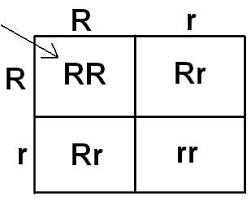
Dihybrid Cross
cross between two individuals with two observed traits that are controlled by two distinct genes.
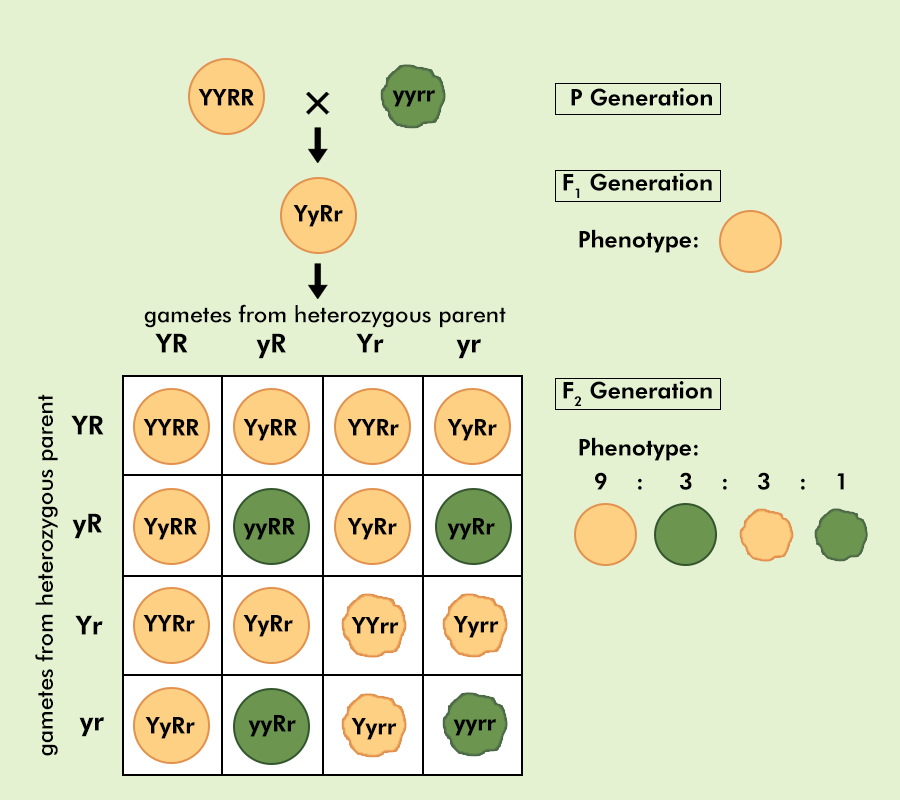
Incomplete Dominance/Blending
a form of Gene interaction in which both alleles of a gene at a locus are partially expressed, often resulting in an intermediate or different phenotype. It is also known as partial dominance. For eg., in roses, the allele for red colour is dominant over the allele for white colour but the offspring comes out as pink
Codominance
a type of inheritance in which two versions (alleles) of the same gene are expressed separately to yield different traits in an individual. for ex: if both the alleles for red and white are dominant in a flower, the offspring will come out with red and white colored petals
Multiple Alleles
When three or more alleles control a trait. (blood types: AB)
Blood Types
a classification of blood, based on the presence and absence of antibodies and inherited antigenic substances on the surface of red blood cells
Polygenic Traits
a characteristic, such as height or skin color, that is influenced by two or more genes. Because multiple genes are involved, polygenic traits do not follow the patterns of Mendelian inheritance. Many polygenic traits are also influenced by the environment and are called multifactorial.
Sex Linked Traits
characteristics (or traits) that are influenced by genes carried on the sex chromosomes. In humans, the term often refers to traits or disorders influenced by genes on the X chromosome, as it contains many more genes than the smaller Y chromosome.
how can you determine a human’s sex based on its chromosomes?
the 23rd chromosomes (sex chromosomes). females have xx and males have xy
Gene-chromosome theory
traits are passed from parents to offspring through gene transmission. Genes are located on chromosomes and consist of DNA. They are passed from parent to offspring through reproduction.
Karyotype
an individual's complete set of chromosomes. The term also refers to a laboratory-produced image of a person's chromosomes isolated from an individual cell and arranged in numerical order.
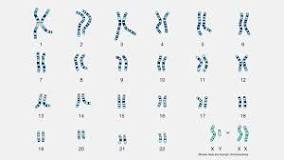
Autosomes
one of the numbered chromosomes, as opposed to the sex chromosomes.
Sex Chromosomes
a type of chromosome involved in sex determination. Humans and most other mammals have two sex chromosomes, X and Y, that in combination determine the sex of an individual. Females have two X chromosomes in their cells, while males have one X and one Y.
Albinism
a rare genetic disorder where you aren't born with the usual amount of melanin pigment. Melanin is a chemical in your body that determines the color of your skin, hair and eyes. Most people with albinism have very pale skin, hair and eyes. They are prone to sunburn and skin cancer.
Cystic Fibrosis
an inherited disorder that causes severe damage to the lungs, digestive system and other organs in the body. Cystic fibrosis affects the cells that produce mucus, sweat and digestive juices. These secreted fluids are normally thin and slippery.
Phenylketonuria (PKU)
a rare inherited disorder that causes an amino acid called phenylalanine to build up in the body.
Tay-Sachs
a rare genetic disorder passed from parents to child. It's caused by the absence of an enzyme that helps break down fatty substances. These fatty substances, called gangliosides, build up to toxic levels in the brain and spinal cord and affect the function of the nerve cells.
Huntington’s Disease
a genetic disorder that causes nerve cells (neurons) in parts of the brain to gradually break down and die. The disease attacks areas of the brain that help to control voluntary (intentional) movement, as well as other areas.
Sickle Cell Anemia
a genetic blood disorder marked by defective hemoglobin. It inhibits the ability of hemoglobin in red blood cells to carry oxygen. Sickle cells tend to stick together, blocking small blood vessels causing painful and damaging complications.
Down Syndrome
Typically, a baby is born with 46 chromosomes. Babies with Down syndrome have an extra copy of one of these chromosomes, chromosome 21. A medical term for having an extra copy of a chromosome is 'trisomy. ' Down syndrome is also referred to as Trisomy 21.
Pedigree
a diagram that shows the occurrence and appearance of phenotypes of a particular gene or organism and its ancestors from one generation to the next, most commonly humans, show dogs, and race horses.
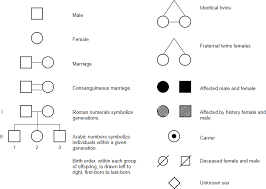
Watson and Crick
James Watson and Francis Crick have been credited with the discovery of the structure of DNA. Watson and Crick used an x-ray photograph that Rosalind Franklin took of DNA. With the help of the photograph they discovered the double helix structure of DNA and built the first DNA model including the basic nucleotide unit. In Watson and Crick's model, the two strands of the DNA double helix are held together by hydrogen bonds between nitrogenous bases on opposite strands. Each pair of bases lies flat, forming a "rung" on the ladder of the DNA molecule.
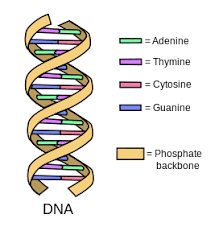
DNA
Deoxyribonucleic acid (abbreviated DNA) is the molecule that carries genetic information for the development and functioning of an organism. DNA is made of two linked strands that wind around each other to resemble a twisted ladder — a shape known as a double helix.
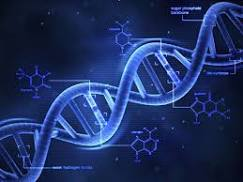
Double helix
a term used to describe the physical structure of DNA. A DNA molecule is made up of two linked strands that wind around each other to resemble a twisted ladder in a helix-like shape.
Nucleotide
the basic building block of nucleic acids (RNA and DNA).
Chromosome
threadlike structures made of protein and a single molecule of DNA that serve to carry the genomic information from cell to cell. In plants and animals (including humans), chromosomes reside in the nucleus of cells.
DNA Replication
the biological process of producing two identical replicas of DNA from one original DNA molecule. DNA replication occurs in all living organisms acting as the most essential part of biological inheritance
Template
the strand that is used during transcription to produce RNA. It is complementary to the coding strand of DNA for the target gene.
DNA Polymerase
a type of enzyme that is responsible for forming new copies of DNA, in the form of nucleic acid molecules. Nucleic acids are polymers, which are large molecules made up of smaller, repeating units that are chemically connected to one another.
Protein Synthesis
the creation of proteins by cells that uses DNA, RNA, and various enzymes.
RNA
Ribonucleic acid (RNA) is a molecule that is present in the majority of living organisms and viruses. It is made up of nucleotides
Uracil
one of the four nucleotide bases in RNA, with the other three being adenine (A), cytosine (C) and guanine (G).
mRNA (messenger RNA)
a molecule that contains the instructions or recipe that directs the cells to make a protein using its natural machinery.
tRNA (transfer RNA)
a molecule that transfers Amino Acids to Ribosomes during protein synthesis.
Ribosome
the cellular machinery responsible for making proteins.
Codon
a DNA or RNA sequence of three nucleotides (a trinucleotide) that forms a unit of genomic information encoding a particular amino acid or signaling the termination of protein synthesis (stop signals).
Anticodon
a trinucleotide sequence located at one end of a transfer RNA (tRNA) molecule, which is complementary to a corresponding codon in a messenger RNA (mRNA) sequence.
Amino Acid
molecules that combine to form proteins. Amino acids and proteins are the building blocks of life. When proteins are digested or broken down, amino acids are the result. The human body then uses amino acids to make proteins to help the body: Break down food
Peptides
a short string of 2 to 50 amino acids, formed by a condensation reaction, joining together through a covalent bond.
Mutations
a mutation is an alteration in the nucleic acid sequence of the genome of an organism, virus, or extrachromosomal DNA
Substitution
a type of mutation in which one nucleotide is replaced by a different nucleotide.
Frameshift Mutations
a genetic mutation caused by a deletion or insertion in a DNA sequence that shifts the way the sequence is read. A DNA sequence is a chain of many smaller molecules called nucleotides.
Insertion
a type of mutation that involves the addition of one or more nucleotides into a segment of DNA. An insertion can involve the addition of any number of nucleotides, from a single nucleotide to an entire piece of a chromosome.
Deletion
changes the DNA sequence by removing at least one nucleotide in a gene. Small deletions remove one or a few nucleotides within a gene, while larger deletions can remove an entire gene or several neighboring genes. The deleted DNA may alter the function of the affected protein or proteins.
Chromosomal Mutations
changes in the number or structure of chromosomes. These mutations can change the location of genes on chromosomes and can even change the number of copies of some genes.
Mutagenic Agents
a chemical or physical agent capable of inducing changes in DNA called mutations. Examples of mutagens include tobacco products, radioactive substances, x-rays, ultraviolet radiation and a wide variety of chemicals.
Selective Breeding
(also called artificial selection) is the process by which humans use animal breeding and plant breeding to selectively develop particular phenotypic traits (characteristics) by choosing which typically animal or plant males and females will sexually reproduce and have offspring together.
Recombinant DNA
DNA molecules formed by laboratory methods of genetic recombination (such as molecular cloning) that bring together genetic material from multiple sources, creating sequences that would not otherwise be found in the genome.
Restriction enzymes
a protein isolated from bacteria that cleaves DNA sequences at sequence-specific sites, producing DNA fragments with a known sequence at each end. The use of restriction enzymes is critical to certain laboratory methods, including recombinant DNA technology and genetic engineering.
Cloning
Cloning is the process of producing individual organisms with identical genomes, either by natural or artificial means. In nature, some organisms produce clones through asexual reproduction; this reproduction of an organism by itself without a mate is known as parthenogenesis.
Human Genome Project
an ambitious research effort aimed at deciphering the chemical makeup of the entire human genetic code (i.e., the genome). The primary work of the project is to develop three research tools that will allow scientists to identify genes involved in both rare and common diseases.
Gel Electrophoresis
a laboratory method used to separate mixtures of DNA, RNA, or proteins according to molecular size. In gel electrophoresis, the molecules to be separated are pushed by an electrical field through a gel that contains small pores.